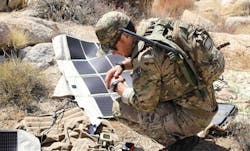U.S. Army Climate Strategy: Microgrid on every base by 2035; Net Zero by 2050
The U.S. Army will not compromise on its primary mission to defend the nation with all means possible, but it plans to face the uncertain future by attaching significant focus to combatting threats posed by climate change.
A wide-ranging Army Climate Strategy plan released Tuesday calls for bold action on many energy security fronts by the fighting force. Many of these offensives are already underway, making progress on fuel efficiency and electrification as well as operational power generation where needed.
In other words, always keep moving forward to the next objective.
“For the foreseeable future, climate impacts will disrupt Army activities, displace individuals and communities and increase the frequency of crisis deployments,” the Army’s Climate Strategy reads. “The Army must act decisively and urgently to address the risks associated with all these effects.”
This strategy is a war of attrition on some levels, with the goal to reduce Army net greenhouse gas emissions 50 percent by 2030 (compared to 2005 levels) and net-zero by 2050. These goals echo similar promises made by companies and government bodies.
On a more immediate, physical level, the U.S. Army intends to install a microgrid at every installation by 2035. This mission ultimately will extend to achieving on-site carbon-free power generation for critical missions at installations only five years later.
Related stories
Microgrid at Fort Hood successfully islands from main Grid
Hurlburt AFB Airfield getting Energy Microgrid Makeover in Florida
The U.S. Army also will embrace e-Mobility in its future energy planning. The force will field an all-electric light-duty non-tactical vehicle fleet by 2027 and take all of the non-tactical fleet electric by 2035.
“Efforts to use less fossil fuel in the Army’s NTV fleet and realize the associated operating cost savings have been ongoing since 2005,” the Climate Strategy release reads. “Through the end of 2020, the Army had removed 18,000 NTVs from its fleet while increasing its inventory of hybrid vehicles by almost 3,000 in the last 3 years alone. These changes have already decreased NTV fleet costs by over $50 million, slashed Army fossil fuel consumption by more than 13 million gallons per year, and reduced the service’s GHG emissions per mile by over 12%.”
The U.S. Army’s historical and heavy reliance on fossil fuels for electricity has increased risks and costs, the strategy says. Thus, the Army is already working with private sector firms to “revolutionize” deployable power generation and energy storage.
More efficient generators building on the Advanced Medium Mobile Power Resource model used since 2013 are a key, the report reads. The Army wants to integrate those gen-sets into microgrids paired with energy storage.
Improving Army supply chain resilience will part of action plans developed by 2028, according to the report.
Click here to see the full U.S. Army Climate Strategy report.
-- -- --
(Rod Walton, senior editor for EnergyTech, is a 14-year veteran of covering the energy industry both as a newspaper and trade journalist. He can reached at [email protected]).
About the Author
Rod Walton, EnergyTech Managing Editor
Managing Editor
For EnergyTech editorial inquiries, please contact Managing Editor Rod Walton at [email protected].
Rod Walton has spent 17 years covering the energy industry as a newspaper and trade journalist. He formerly was energy writer and business editor at the Tulsa World. Later, he spent six years covering the electricity power sector for Pennwell and Clarion Events. He joined Endeavor and EnergyTech in November 2021.
Walton earned his Bachelors degree in journalism from the University of Oklahoma. His career stops include the Moore American, Bartlesville Examiner-Enterprise, Wagoner Tribune and Tulsa World.
EnergyTech is focused on the mission critical and large-scale energy users and their sustainability and resiliency goals. These include the commercial and industrial sectors, as well as the military, universities, data centers and microgrids. The C&I sectors together account for close to 30 percent of greenhouse gas emissions in the U.S.
He was named Managing Editor for Microgrid Knowledge and EnergyTech starting July 1, 2023
Many large-scale energy users such as Fortune 500 companies, and mission-critical users such as military bases, universities, healthcare facilities, public safety and data centers, shifting their energy priorities to reach net-zero carbon goals within the coming decades. These include plans for renewable energy power purchase agreements, but also on-site resiliency projects such as microgrids, combined heat and power, rooftop solar, energy storage, digitalization and building efficiency upgrades.

